A Nobel Prize winning author, Ernest Hemingway (July 21, 1899 – July 2, 1961) is regarded as one of the greatest American writers of all time. Apart from being a world renowned author, he was also one of the most fascinating figures of the modern age. There are numerous interesting incidents from his life like his being dressed as a girl when he was a child, his involvement with both the Soviet and US Intelligence, his plan to battle German U-Boats during the Second World War and his satirical novel that targeted his own friends. Here are 10 facts on Ernest Hemingway, one of the most interesting literary figures of the 20th century.
#1 HIS MOTHER LIKED TO DRESS HIM AS A GIRL
Ernest Hemingway’s mother Grace Hemingway liked to maintained baby books regarding her little children; noting things that she may have found special including photographs. In some of these pictures the little Ernest may be seen dressed as a girl, looking pretty in lacy dresses, pink bows and page-boy haircuts. Though this wasn’t uncommon a century ago, Grace Hemingway did go far with her fancy ideas. She had always wanted to have twins. She first gave birth to her eldest daughter Marelline in January 1898 and Ernest followed the next year in July. As the children grew and somewhat resembled each other, Grace Hemingway began to dress Ernest to look like Marelline, and began treating them as her twin daughters.

His mother’s obsession with twins remained a constant theme in Hemingway’s early childhood and he was often called ‘Ernestine’ by her. Ernest had shoulder-length hair matching his sister and got his first haircut only when he was 6. Marelline on the other hand had to drop a year so that she would be in the same grade as Ernest. In one of her notes Grace writes of Ernest, “He was quite fearful before Christmas that Santa Claus wouldn’t know he was a boy.” There have been rife speculation about how these events influenced Ernest’s later behavior and life, with feminist biographer Mary Dearborn going as far as equating them with what she calls as Hemingway’s ‘lifelong tendency toward androgyny’, along with other things from his less than impressive private life.
Main Sources:-
Sanford, Marelline Hemingway. 1961,1962. “At The Hemingways”. P61,62. The Atlantic Monthly Press.
Leonard, Tom. May 20, 2017. “He’s the great symbol of manhood. But did being dressed as a girl by his mother leave Hemingway confused about his sexuality?”. Dailymail.co.uk.
Metts, John. Jan 16, 2016. “Ernest Hemingway: Psychological Profile”. Academia.edu
#2 HE WAS THE DE FACTO BODYGUARD FOR JAMES JOYCE
The famous Irish author James Joyce became acquainted with Ernest Hemingway during the 1920s in Paris. As both were excessively fond of alcohol, they soon became drinking buddies and began to frequent cafes and bars together. Sometimes these drinking sessions would lead to bar fights. Joyce, who was physically unassuming with bad eyesight, would immediately seek the protection of Hemingway. Ernest was tall, athletic and always up for a fight and if Joyce ever picked a fight he would hide behind his more imposing comrade and shout “Deal with him, Hemingway, deal with him!.”
Main Sources:-
Macdonald, Fiona (Oct 21, 2014). “Startling facts about Ireland’s most famous writers”. BBC
“Deal with him Hemingway”
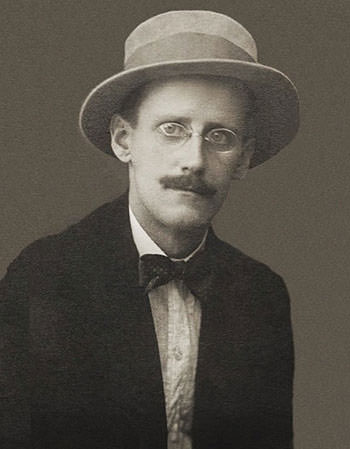
#3 HEMINGWAY WROTE A SATIRICAL NOVEL TARGETING HIS OWN FRIENDS
Hemingway’s early days in Paris after the First World War were guided by the friends and contemporary writers like Sherwood Anderson and Gertrude Stein. It was in fact Anderson who had suggested Hemingway to stay in Paris after the later was selected as the foreign correspondent for the Toronto Star. Anderson had also introduced him to art collector and author Gertrude Stein, whose Paris salons were a confluence of many notable writers and artists of the era. These would include the likes of Pablo Picasso, F. Scott Fitzgerald, Sinclair Lewis, Ezra Pound and Henri Matisse, apart from Anderson and Hemingway themselves. By 1925-26, however, Hemingway had grown irritated with many of his friends whom he considered as fake and pretentious. In 1926 he would go ahead and target them in his lesser known novel The Torrent of Spring, written as a deliberate parody of Sherwood Anderson’s Dark Laughter. The rift created by The Torrents of Spring would never be mended and their friendships would dwindle out with time.
Main Sources:-
Mellow, James R. 1992. “Hemingway A Life Without Consequences”. P316-318. Addison-Wesley Publishing Company.
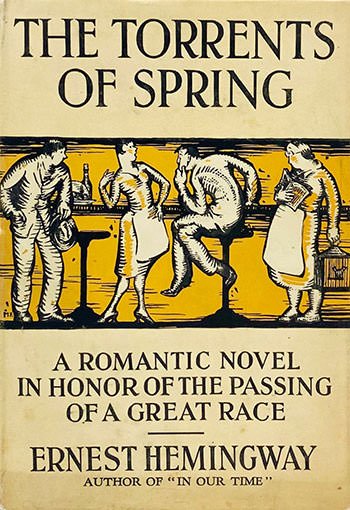
#4 HE MAY HAVE DELIBERATELY MANEUVERED HIS WAY OUT OF A CONTRACT
Though Hemingway obviously denied this, it is widely believed that The Torrent of Springs was the writer’s carefully engineered plan to get out of his contract with Boni and Liveright. The publisher had published In Our Time with Hemingway and held the right of first refusal for his three books, one of which was to be a novel. There was however a proviso that if they rejected his second book, they would have no claim over the third. Written hastily in November 1925, the 28,000 word novel was a satirical work deliberately written to cause problems with the publisher.
The book was a satire on pretentious writers and parodied Sherwood Anderson’s Dark Laughter released earlier in the year. Anderson was another client of the publisher and a friend of Hemingway. In a letter to Ezra Pound, Hemingway claimed that the novel was “possibly unprintable but funny as hell”, indicating that he was expecting the publisher to turn it down. The Torrent of Springs was indeed the deal breaker for Boni and Liveright, and Hemingway was free to negotiate his deal with Scribner’s. In January 1926, Max Perkins at Scribner’s agreed to publish The Torrents of Spring in addition to Hemingway’s future work.
Main Sources:-
Mellow, James R. 1992. “Hemingway A Life Without Consequences”. P316-318, 321. Addison-Wesley Publishing Company.
#5 HE MADE A PLAN TO BATTLE GERMAN U-BOATS DURING WW2
Hemingway was passionate about fishing and in 1934 had acquired a 38 foot long fishing boat which he named “Pilar”. A decent sailor, he regularly fished off the boat in the waters close to his properties in Key West, Florida and Cuba. During the Second World War the German U boats (submarines) were wrecking havoc on Allied shipping, and were also attacking US ships in the Caribbean. At this time Hemingway was in Cuba and came up with an outlandish plan to disable these submarines via his personal fishing boat. The plan called Operation Friendless proposed that the Pilar would patrol the seas and if it encountered a German boat, certain crew members would fling grenades into the submarine hatch while others would target the enemy vessel with machine guns. The plan did receive some support from the US Office of Naval Intelligence which aided in upgrading Pilar with depth charges, machine guns, radio equipment and rebuilt engines. However the plan (perhaps thankfully) was never put to test as the Pilar never encountered an enemy ship.
Main Sources:-
Swanson, Peter (Oct 3, 2007). “Saving Pilar and Hemingway”. Yachting Magazine.
Feldman, Andrew (Jun 24, 2019). “What Was Hemingway Doing in Cuba During World War II?”. Literary Hub.
FBI Records: The Vault -Ernest Hemingway P37.
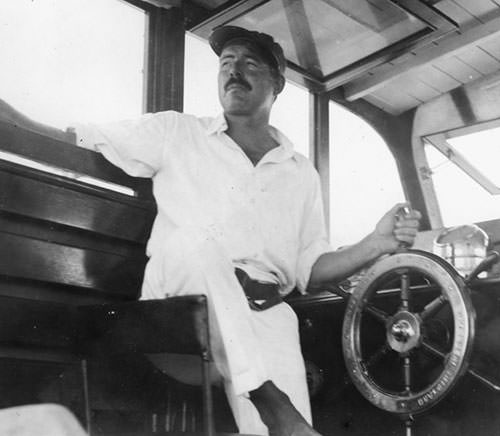
#6 HE WAS FORMALLY BOOKED FOR THE CONTRAVENTION OF THE GENEVA CONVENTION
In June 1944, Hemingway working as a war correspondent for the American magazine Collier’s, accompanied the Allied troops at the Normandy Landings of World War II. Later in July, during the Battle of the Hürtgen Forrest, Hemingway became acquainted with Colonel Charles T. Lanham commanding the 22nd Infantry Regiment. He then made Latham’s command post his base as a reporter. It was around this time as the Regiment was marching towards Paris, that Hemingway led a controversial effort to gather military intelligence in the village of Rambouillet (just outside Paris) and became the de facto leader of a small band of village militia. This was in fact a contravention of the Geneva Convention where a correspondent is forbidden to lead troops in anyway. Hemingway was thus booked formally for this adventure and only saved himself by claiming that he was just offering advice.
Main Sources:-
“Charles Trueman Lanham”. 1-22infantry.org.
Putnam, Thomas (2006). “Hemingway on War and Its Aftermath”. archives.gov.
Gasser, Hans-Peter (28 Feb, 1983). “The protection of journalists engaged in dangerous professional missions”. International Committee of the Red Cross.
“Report of Investigation, Alleged Combat Activities of Mr. Ernest Hemingway”.
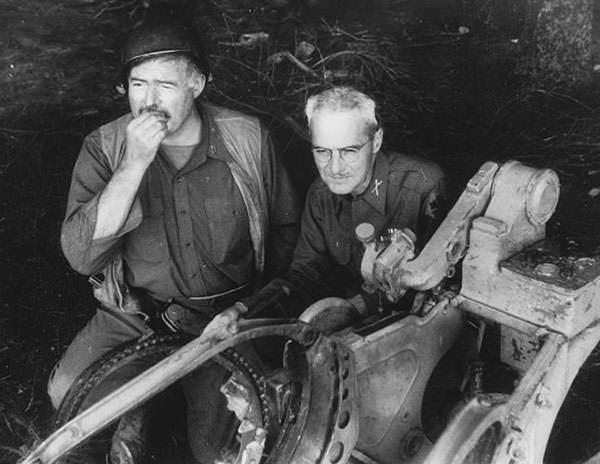
#7 HEMINGWAY WORKED FOR BOTH THE SOVIET AND US INTELLIGENCE
Certain 1940s Soviet records that were later accessed reveal that Ernest Hemingway had agreed to be recruited by the NKVD, the Soviet intelligence agency that was the predecessor of the KGB. Translated excerpts of Hemingway’s Soviet file further reveal that he was given the code name “Argo” and was recruited by Jacob Golos, a top agent in the NKVD office in New York. Hemingway first came to the Soviets’ attention when he was covering the Spanish Civil War (1936-1939) and may have agreed to help the Soviets due to his strong anti-fascist beliefs. The Soviet files also suggest that the author did not pass on any useful information but “repeatedly expressed his willingness and desire to help us.” The fact was also corroborated by the Hemingway’s letters where he had admitted doing odd jobs for the NKVD.
Quite extraordinarily Hemingway also worked as a spy for the Office of Strategic Services, the predecessor to the CIA. He was recruited by the American Embassy in Havana, where Hemingway formed an informal intel group he called the “Crook Factory.” His agents were bartenders, wharf rats, former bullfighters, priests and exiled counts. His work included keeping an eye on Spanish citizens in Cuba and look out for ties with Franco, the Spanish fascist dictator. The agency suspected Spain may have been trying to get Cuba to join the Axis powers. The Crook Factory’s intelligence operation ceased in April 1943.
Main Sources:-
Mar 11, 2017. “Was Ernest Hemingway a player in international espionage?”. Cbsnews.
Davis, Paul. Jan 13, 2020. “Was Hemingway a Soviet spy?”. The Washington Times
#8 HE WANTED TO ‘LIBERATE’ THE RITZ HOTEL FROM THE GERMANS
In August 1944, Ernest Hemingway was in Paris as a war correspondent for the American magazine Collier’s. An enthusiastic personality wanting to be in the thick of the action, Hemingway had volunteered for the US Intelligence. He had spent a month hurtling in a Jeep between the front lines, making contact with local French Resistance fighters between the advancing US forces and the retreating Germans. The Ritz Hotel in Paris had fascinated Hemingway ever since his 1920s days in the city. Upon realizing that the Germans had been using the luxurious hotel, Hemingway with the help of his contacts managed to meet up with French commander General Philippe Leclerc.
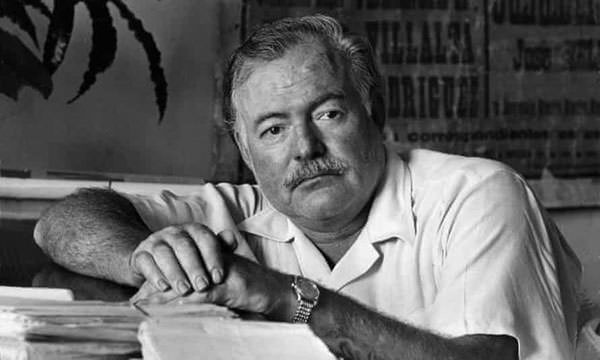
During the meeting Hemingway requested that he may be given enough men to liberate the Ritz, and was taken by surprise when the General dismissed his idea. Hemingway however persisted and on August 25, 1944, turned up at the hotel in a Jeep mounted with a machine gun and heading what he called some ‘Irregular’ Resistance fighters. The group was soon informed that the Germans had left a long time ago, but Hemingway ensured it wasn’t a wasted effort and quickly hit the bar. There were reportedly more than 50 martinis on his tab by the time he had finished drinking that night.
Main Sources:-
Aug 12, 1919. “The day Hemingway liberated the Ritz bar in Paris”. france24.com
#9 HEMINGWAY’S SCRIPTS WERE RETRIEVED FROM CUBA WITH THE HELP OF THE US GOVERNMENT
In 1960, after spending almost 2 decades at the Finca Vigía (“Lookout Farm”), their home in Havana, Ernest Hemingway and his wife Mary were forced to leave Cuba. The reason was the regime change under Fidel Castro seemed intent on nationalizing property owned by Americans. Shortly after Hemingway’s death in July 1961, his boat and other belongings were expropriated by the Castro regime. The Cuban government had made an offer to Mary Hemingway; to donate the home in Cuba for a museum, and in exchange take all the Hemingway papers from the Bank and her personal belongings. There was however a problem, the US-Cuban diplomatic relations were off. Considering the stature of Hemingway as an American icon an exception was made for Mary. With the help of President Kennedy, special permission was granted for Hemingway’s fourth wife and widow, to go to Cuba to collect her husband’s belongings. Mary would retrieve all of Hemingway’s papers and forty pounds of manuscripts from the bank vault in Cuba. These would later be archived in “The Kennedy Presidential Library and Museum in Boston.” It would be the repository for the world’s largest collection of documents, photographs and personal mementos belonging to Hemingway.
Main Sources:-
Apr 13, 2013. “Rare Hemingway manuscripts from Cuba go on display at JFK Library”. Fox News.
Meyers, Jeffery. 1985. “Hemingway – A Biography”. P566. Harper and Row.
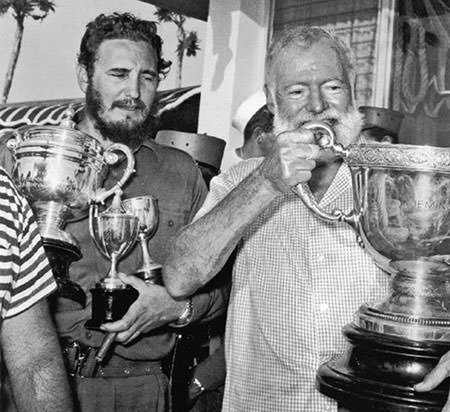
#10 HEMINGWAY GAVE HIMSELF THE NICKNAME “PAPA”
Contrary to his understated and precise writing style as an author, Ernest Hemingway can be observed as a lively and effervescent conversationalist in his letters to his family and friends. These correspondences are often brimming with anecdotes and humor, which are especially evident in the many whimsical nicknames he invents for those known to him. Quite unusually Hemingway’s creativity with nicknames even extended to himself. At various times in his early years he refers to himself as “Oin”, “Oinbones”, “Old Brute” and “Wemedge”. In high school he was called “Hemingstein”, which was often shortened to “Stein” or “Steen”. However it was in the 1920s that Hemingway would find a nickname that would finally stick. In 1923, while traveling to the Festival of San Fermín in Pamplona, Spain, Hemingway became fascinated by bullfighting. It was around this time that he began to be referred to as “Papa”, a nickname that is now always associated with the author.
Main Sources:-
Feb 3, 2012. “Hemingway and Nicknames”. cambridgeblog.org.
Brucolli, Matthew J (1986) “Conversations with Ernest Hemingway”. P42. University Press of Mississippi.
Kibbe, Kayla. “Why Can’t We Let Go of “Papa” Hemingway?”. InsideHook

